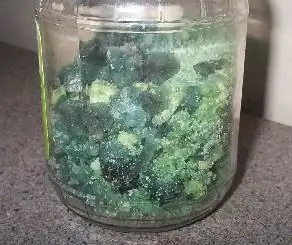2025 Author: Howard Calhoun | [email protected]. Last modified: 2025-01-24 13:10:41
Phthalic acids are important representatives of polybasic carboxylic compounds of the aromatic series, represented by some isomers - ortho-isomer (directly, phthalic acid), meta-isomer (isophthalic) and para-isomer (terephthalic). All substances of this group are extremely widely used in various industries.

Terephthalic acid is a colorless pure crystalline powder obtained during the reaction of liquid-phase oxidation of para-xylene in the presence of cob alt s alts acting as catalysts. The interaction of this substance with various alcohols leads to the formation of chemical compounds of the ether group. Dimethyl terephthalate has the greatest practical application.
Terephthalic acid is also used for the synthesis of polyethylene terephthalate (PET) - a transparent heat-resistant polymer obtained as a result of the polycondensation reaction of this substance with ethylene glycol. Then from itproduce plastic bottles, polyester fibers of the terylene group, better known under the common name "lavsan", as well as various packaging containers for the food industry, radio components and various equipment.

In terms of its chemical properties, terephthalic acid is similar to monobasic carboxylic compounds. When heated or under the influence of so-called water-removing substances, it easily forms s alts, esters of a complex molecular structure, anhydrides, amides, both in one and in two carboxyl groups. Also, terephthalic acid enters into an esterification reaction, as a result of which mono- and diesters are formed. When this crystalline substance is heated to a temperature of at least two hundred degrees, decarboxylation is observed with the formation of compounds containing a smaller number of carboxyl groups. However, electrophilic substitution reactions in the deactivated ring begin to proceed with great difficulty.

Phthalic acid is naturally found in the green pigment of plants and poppy seed pods. Of its derivatives, the most important are the ether compounds dibutyl and dimethyl phthalate, which are used as plasticizers for cellulose products, vinyl polymers, and rubbers. Also, dimethyl-, diethyl- and dibutylphthalates are important components of various repellents.
Isophthalic acid is actively used in the manufacture of unsaturated polyester resins. Because isophthalates are excellent plasticizers. Butterephthalic acid, which is used for the synthesis of such industrially important substances as dimethyl terephthalate and polyethylene terephthalate, has the greatest application from the group of benzene-polycarboxylic compounds. They are used for the manufacture of drive belts for various mechanisms, ropes, conveyor belts, fishing nets, sails, ship gear, trawls, gasoline and oil resistant hoses, zippers, tennis racket strings and much more. In addition, knitwear, various fabrics (crepe, tweed, satin, etc.), curtain and tulle products, raincoat, umbrella and costume materials, shirts, stockings, children's clothing are made from smooth textile threads, in the production of which this substance is used. etc.
In conclusion, I would like to note that all acids of the benzene polycarboxylic series are extremely aggressive and toxic substances. Therefore, they are always accompanied by a material safety data sheet, which indicates all the properties and characteristics of this compound, as well as the procedure and rules for working with it.
Recommended:
Polyols are polyhydric alcohols (polyalcohols): properties, production and applications

Polyols - safe or not? What are polyalcohols, why are they included in the composition of chocolate, chewing gum, foam rubber and antifreeze. The most famous polyols are sweeteners. Production of polyhydric alcohols in Russia and abroad
Ferrous sulfate: physical and chemical properties, production, application

Ferrous sulfate is a chemical compound that is extremely common in nature and widely used in various fields of economic activity. There are divalent and trivalent modifications of this substance. The first variety, also called ferrous sulfate, is an inorganic binary non-volatile compound having the formula FeSO4
Chloroacetic acid: preparation and chemical properties

Chloroacetic acid is an extremely dangerous substance. Inhalation of its vapors can lead to severe damage to the lungs and respiratory tract
Titanium carbide: production, composition, purpose, properties and applications

Titanium carbide: the history of the discovery of this compound, chemical and physical and mechanical properties. Description of how to obtain it. Part coating, carbide steel fabrication and other titanium carbide applications
Wood wool: production, properties and applications

What is wood wool? A little product history. What is the main use of wood wool? Let's also talk about additional uses. Characteristics and main properties. Average cost of wood wool

